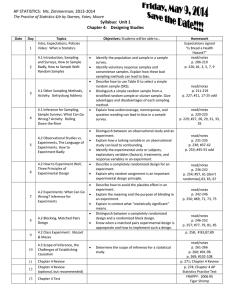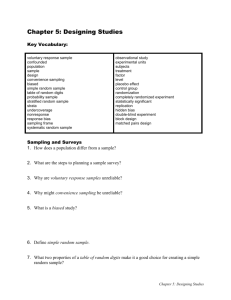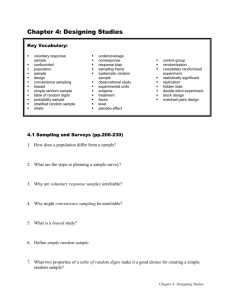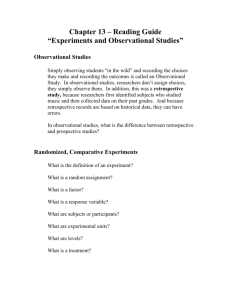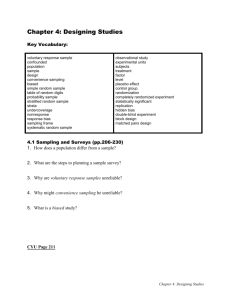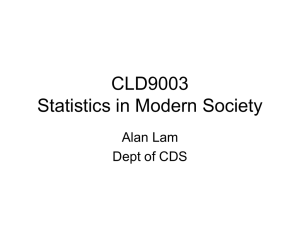AP Stats Chapter 4 - Warren County Schools
advertisement
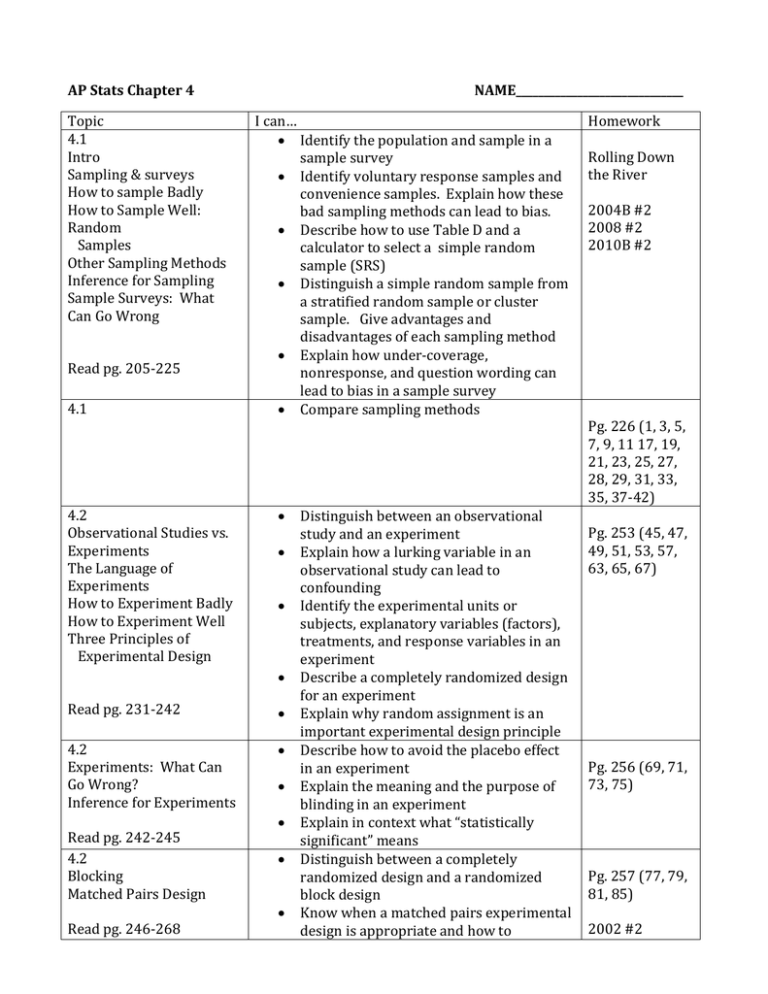
AP Stats Chapter 4 Topic 4.1 Intro Sampling & surveys How to sample Badly How to Sample Well: Random Samples Other Sampling Methods Inference for Sampling Sample Surveys: What Can Go Wrong Read pg. 205-225 4.1 4.2 Observational Studies vs. Experiments The Language of Experiments How to Experiment Badly How to Experiment Well Three Principles of Experimental Design NAME______________________________ I can… Identify the population and sample in a sample survey Identify voluntary response samples and convenience samples. Explain how these bad sampling methods can lead to bias. Describe how to use Table D and a calculator to select a simple random sample (SRS) Distinguish a simple random sample from a stratified random sample or cluster sample. Give advantages and disadvantages of each sampling method Explain how under-coverage, nonresponse, and question wording can lead to bias in a sample survey Compare sampling methods Read pg. 231-242 4.2 Experiments: What Can Go Wrong? Inference for Experiments Read pg. 242-245 4.2 Blocking Matched Pairs Design Read pg. 246-268 Distinguish between an observational study and an experiment Explain how a lurking variable in an observational study can lead to confounding Identify the experimental units or subjects, explanatory variables (factors), treatments, and response variables in an experiment Describe a completely randomized design for an experiment Explain why random assignment is an important experimental design principle Describe how to avoid the placebo effect in an experiment Explain the meaning and the purpose of blinding in an experiment Explain in context what “statistically significant” means Distinguish between a completely randomized design and a randomized block design Know when a matched pairs experimental design is appropriate and how to Homework Rolling Down the River 2004B #2 2008 #2 2010B #2 Pg. 226 (1, 3, 5, 7, 9, 11 17, 19, 21, 23, 25, 27, 28, 29, 31, 33, 35, 37-42) Pg. 253 (45, 47, 49, 51, 53, 57, 63, 65, 67) Pg. 256 (69, 71, 73, 75) Pg. 257 (77, 79, 81, 85) 2002 #2 4.3 Scope of Inference The Challenges of Establishing Causation Data Ethics Chapter 4 Review implement such a design Determine the scope of inference for a statistical study Evaluate whether a statistical study has been carried out in an ethical manner Pg. 260 (91-98, 102-108) Pg. 254 (55, 83, 87, 89) Ch 4 Review Ch 4 Mult Ch WS #1-24 Ch 4 Test Ch 4 Mult Ch WS #25-48 Chapter 4 Test Free Response: 1997 #2 blocking 1999 #3 exp vs obs study, confounding 2000 #5 blocking, double-blind 2001 #4 blocking, randomization purpose 2002 #2 matched pairs, double-blind 2002B #2 blocking 2003 #4 randomization, control groups 2004 #2 blocking, random within blocks 2004B #2 bias 2005 #1 stem-plots, sampling variability 2006 #5 treatments, randomization 2006B #5 treatments, confounding 2007 #2 control groups, blocking 2007B #3 blocking, randomization 2008 #2 nonresponse bias 2009 #3 random and nonrandom 2010 #1 treatments, scatterplots 2010B #2 SRS & stratified rand sampling 4.1 Identify the population and sample in a sample survey Identify voluntary response samples and convenience samples. Explain how these bad sampling methods can lead to bias. Describe how to use Table D and a calculator to select a simple random sample (SRS) Distinguish a simple random sample from a stratified random sample or cluster sample. Give advantages and disadvantages of each sampling method Explain how undercoverage, nonresponse, and question wording can lead to bias in a sample survey Compare sampling methods 4.2 Distinguish between an observational study and an experiment Explain how a lurking variable in an observational study can lead to confounding Identify the experimental units or subjects, explanatory variables (factors), treatments, and response variables in an experiment Describe a completely randomized design for an experiment Explain why random assignment is an important experimental design principle Describe how to avoid the placebo effect in an experiment Explain the meaning and the purpose of blinding in an experiment Explain in context what “statistically significant” means Distinguish between a completely randomized design and a randomized block design Know when a matched pairs experimental design is appropriate and how to implement such a design 4.3 Determine the scope of inference for a statistical study Evaluate whether a statistical study has been carried out in an ethical manner
